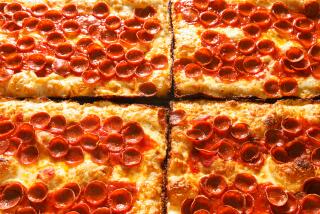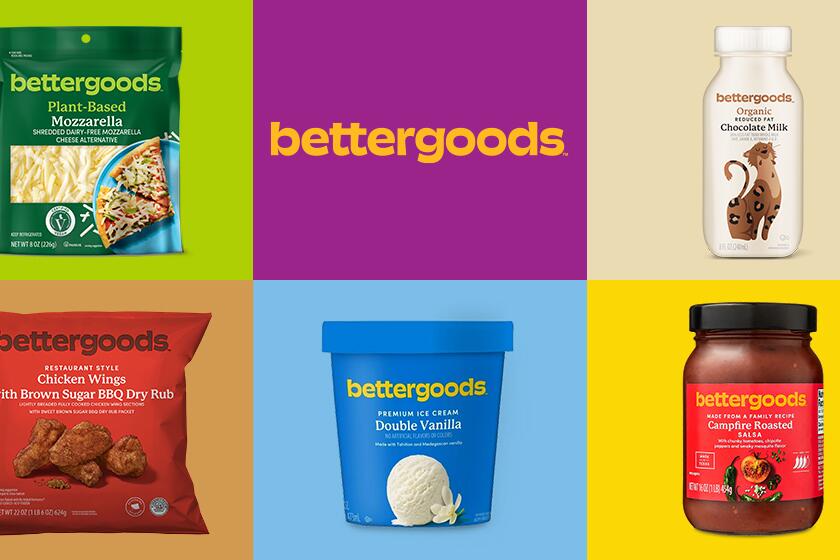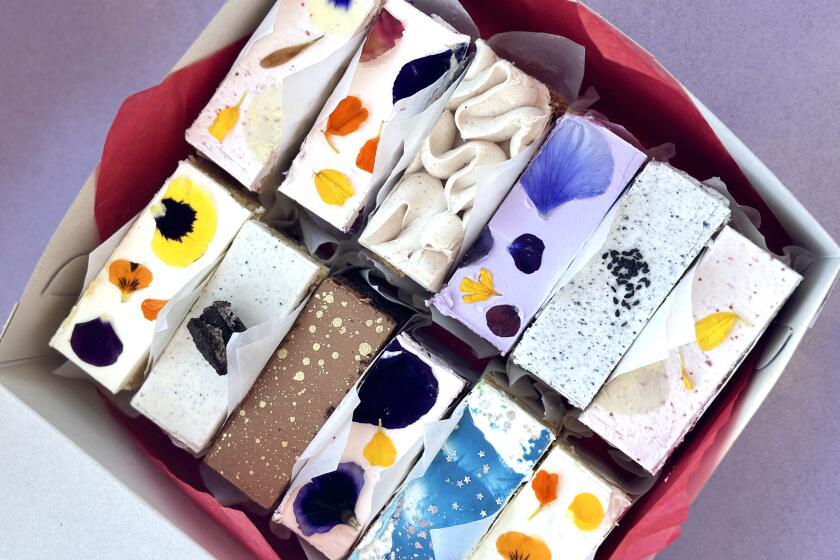The world according to Gallo
If Joe Gallo has his way, everyone in the world will be drinking Gallo wines. They just won’t know it.
The American vintner’s new French wine, Red Bicyclette, is tailor-made for America’s sweeter-is-better palate. Gallo’s got the consumer research to prove it’s going to be a winner and the marketing muscle to push it through grocery stores and discount chains around the country.
But Gallo’s plans for this sunny vin de pays from France’s Languedoc region don’t stop at the U.S. border. The whimsical Frenchman on a spindly red bike that graces the bright yellow label, first seen last fall on American supermarket shelves, will be doing a tour de France -- showing up in wine stores throughout the country, and then pedaling across Europe.
It is the globalization of wine a la Gallo, a challenge not just to French vintners making wine on their own turf but to the entire Old World of wine. Eventually, Gallo plans to produce wines in every major winemaking region on the globe.
“French wine is the gold standard,” says Gallo, noting that his research shows that American consumers consider it the best wine in the world. But they’re drinking less and less of it because it’s too hard to understand, Gallo says. It is a pattern of declining consumption that holds true with French wine drinkers in France as well, according to Gallo.
With Italian wine, says Gallo, there’s a similar paradox. “Americans love Chianti. They just don’t like the way it tastes.” The romantic image in consumers’ imaginations doesn’t fit with the dry, acidic wines they’ve had to drink. So, again, they are buying less and less of it, says Gallo’s market research.
Breaking free of these patterns won’t be easy. And Gallo’s reputation as the maker of Hearty Burgundy jug wine is no help. As it did with its first Italian wines -- Ecco Domani and Bella Sera are the alpha and beta tests of this international strategy -- Gallo chose not to put its name on the imported bottles or the marketing materials. They’re Gallo wines, but they don’t say Gallo.
For consumers, Red Bicyclette is a fun wine from Southern France; Gallo’s Da Vinci Chianti is a Tuscan Sangiovese that happens to be made in Leonardo da Vinci’s hometown; and Pont d’Avignon, a Cotes-du-Rhone that Gallo plans to introduce in March, is a wine made by a French vintner who must live in that lovely place we all grew up singing about.
In reality, it is the on-the-nose, unintimidating wine names and the eye-popping labels that actually give away the fact that these are Gallo wines. The road to world domination for the largest producer of American wine -- Gallo shipped 70 million cases of California wine last year -- has been paved with years of disciplined market research.
Gallo’s new international focus is a dramatic departure from the family’s California-centric past, only recently made evident as Gallo has announced one after another of its international wines. Each wine is made with a partner in the region: a French grape cooperative in the Languedoc, another in the Cotes-du-Rhone, an Italian cooperative in Chianti. Gallo also recently partnered with Whitehaven, a family-owned winery in New Zealand, and McWilliam’s, a family-owned wine company in Australia.
The rollout continues this year as Gallo plans to announce a wine project in Chile; a Gallo wine from Germany will be next.
No one in the wine industry has ever tried to make so many new wines in so many different places at the same time, according to industry analysts.
Sure, American wine companies have created international partnerships before, but mostly to make high-end prestige wines for the American market. Gallo is targeting mass markets -- $10 wines that appeal to serious wine drinkers as everyday bottlings and, for the less experienced, that work as special-occasion wines. In each case, the American-model wines will be marketed in the foreign countries where they are produced, after they’re introduced in the U.S.
Gallo is making French wine to sell in Paris? The whole subject of the globalization of wine has become a cause celebre in France with the release of the documentary film “Mondovino,” which celebrates France’s quirky small vintners (to be released in Los Angeles in the spring). A few Gallic farmers rioting over McDonald’s hamburger stands may look tame when the French get wind of Gallo’s hubris.
But, of course, Joe Gallo tells me in an interview: The French need Gallo.
A careful man with the bearing of someone well aware of the singular influence his family holds within the American wine industry, Gallo deliberated for months before agreeing to talk with the Los Angeles Times. Since his family started E.&J.; Gallo Winery after Prohibition in the 1930s, the company has talked to the press only on select occasions. Joe Gallo, the 64-year-old driving force within the company for the past decade, rarely makes public comments.
Once committed, however, he took charge, suggesting a long lunch at the photogenic ranch that once belonged to actor Fred MacMurray and is now a Gallo vineyard. He chartered a plane from the company’s Central Valley headquarters in Modesto to be able to make the 10:30 a.m. appointment during Christmas week, when the ranch was decorated for a 1950s-style holiday homecoming.
Wearing a couture sweater, Gallo passes on the wine to sip iced tea as he listens intently to the conversation in the small family living room. He answers some questions directly. More often, he nods to one of the members of his marketing staff to respond, creating an underlying tension in the room as the small circle of men waits to be picked to speak.
Following in his 95-year-old father Ernest Gallo’s footsteps, Joe Gallo runs the marketing side of the family-owned company. His cousin Bob Gallo, Julio’s son, plays second fiddle as the manager of Gallo’s tens of thousands of acres of vineyards and its network of wineries, anchored by the world’s largest winery in Modesto.
A shift in focus
Starting in the mid- 1990s, Joe Gallo began redirecting the company to become a global player, taking it from zero imports to its position today as the country’s third-largest importer of wine. He created three Italian brands: Ecco Domani (launched eight years ago and now selling more than 800,000 cases a year), Bella Sera (launched four years ago and now selling 1.7 million cases a year) and Maso Canali (a 2-year-old premium Pinot Grigio brand), as well as the phenomenally successful Black Swan brand from Australia (launched two years ago and now selling more than 1.3 million cases a year), according to industry estimates. Although Maso Canali sells for more than $15 a bottle, the others can be found in grocery stores for less than $10 a bottle.
That doesn’t mean Gallo has been ignoring the opportunities to scoop up domestic wine companies stretched thin by the ongoing international wine glut. In another departure from the past, Gallo two years ago acquired Louis M. Martini and Mirassou wineries. More recently, it bought Bridlewood Estate Winery in the Santa Ynez Valley to create a Syrah-centric brand. Last week, Gallo bought Barefoot Cellars, a Sonoma-based negociant.
Rival wine company Constellation Brands’ more aggressive acquisition spree -- the New York-based conglomerate recently purchased the Robert Mondavi Corp. -- has pushed that company slightly ahead of Gallo in worldwide wine production with 90 million cases a year (Gallo’s worldwide production is 75 million cases a year). But, says wine industry analyst Jon Fredrickson, Gallo remains the “omnipotent” American wine company.
Importing an initial 250,000 cases of Red Bicyclette at the end of 2004, Gallo single-handedly stopped an eight-year-long slide in the sales of French wine in the United States, says Fredrickson.
Gallo does its homework. The company’s forays around the world are based on voluminous consumer research, a constant stream of one-on-one interviews and market tests.
European winemakers have lost touch with the American consumer, says Gallo: “Their price points are too high and the explanations of their wines are far too complex.” The enormous range of smells and flavors simply overwhelms and turns off most Americans, he says.
Places like Chianti “have been making wine the same way for 100 years,” Gallo notes, incredulous that they would allow themselves to be so mired in the past.
The trick: Make wine that reminds Americans of the favorable images and then deliver a simpler, more familiar flavor profile in a package that is easy to understand.
“It’s about making wine with an absence of negatives,” Gallo says, introducing a phrase he repeats several times during the four-hour interview.
Americans raised on the simple flavors of ketchup and Coke want to drink sweeter, fruitier wines that they can rely on, according to Gallo. No surprises. Nothing unpleasant. That’s the basic blueprint for Gallo’s international wines.
Is Gallo “dumbing down” French and Italian wines to make them palatable to Middle America? I ask.
“Why shouldn’t we?” responds Gerry Glasgow, Gallo’s head of marketing for 23 years. “If we can make wine more appealing by removing the things that some people find objectionable -- acids and tannins -- then that’s what needs to be done.”
Gallo interrupts, advising Glasgow to sound more respectful of consumers.
“Too many Americans have been humiliated when they were ordering a bottle of French wine in a restaurant,” continues Glasgow. The difficult-to-pronounce names, the confusing labels -- both remind Americans of their preconceived notion that the French are condescending and arrogant, he says. In late 2002, Gallo was trying to understand American attitudes toward all things French; the political climate between the two countries sank to new lows with France’s opposition to America’s invasion of Iraq. The project went forward when Gallo market-tested an image of French village life in the rural south, particularly Provence. Suddenly the scores shot up: These French people were OK, nothing like the awful Parisians.
Pictures and profiles
To find a marketable image, “we spent 10 days just hanging out in the South of France taking pictures, 6,000 or 7,000 pictures,” says Iain Douglas, a rising star in Gallo’s marketing department. “When we came back, we put them all up in a room.”
To Gallo’s surprise, there were hundreds of pictures of red bicycles all over the walls. It was something they hadn’t paid much attention to while they were there.
The first mock label used a picture of an old bike. Called Red Bike, it was an instant thumbs down in test markets -- too real and not clearly French. Bike became Bicyclette to make it more French. But red did not become rouge. That would have been too French, according to Douglas. Distancing the wine from the reality of France by replacing the real bike with a goofy cartoon sent market test scores soaring, he says.
“We’ve made French wine approachable, not some chateau you can’t pronounce,” says Gallo proudly.
With Da Vinci, the label image is an on-the-money reproduction of a pen-and-ink Leonardo da Vinci drawing on parchment of a beautiful woman. For Pont d’Avignon, it’s a drawing of a French village, brightened with mustard-colored paper.
Each of Gallo’s international partnerships follows the same pattern: Gallo creates and owns the brands, handling marketing and distribution. The foreign partner manages the vineyards and wineries, neither of which are owned by Gallo.
“It’s presumptuous for us to try to do this by ourselves,” says Gallo. “They know the customs, the history, the nuances of the area.”
But they don’t know how to make wine for American consumers. To teach them, Gallo developed a computer program.
Joe Gallo motions to Douglas to open the laptop computer he is carrying. Up pops a four-quadrant, three-dimensional grid speckled with different-colored dots. Some bear the names of flavor adjectives; others note the world’s Pinot Noir producers.
“That’s sulfur/cabbage/dill here with fruity/floral down here,” says Douglas. “This quadrant contains thick brown spices/cooked fruit. The next one has acid/hot/bitter/long aftertaste/citric. That axis is oak/vanilla/caramel/butter.”
The universe of Pinot Noir flavors has been reduced to dots on a computer screen.
I lean over to get a better look at the screen, eager to see whose wines taste like what and which flavors scored highest with consumers. Gallo nods to Douglas, who snaps the computer shut. “It’s proprietary,” says Gallo.
Gallo has created a computerized “flavor profile” for each varietal wine. The grids compile Gallo’s consumer research (thousands of interviews every year that now include consumers outside the United States). These are married to detailed flavor descriptions of each commercially produced wine of that varietal compiled by a Gallo panel of internal and external professionals trained to analyze wine.
For instance, with Chardonnay, Gallo’s professional panel tasted 400 Chardonnays from around the world. Out of those wines, the panel discerned 39 discrete styles of the varietal. Gallo then had a range of consumers taste and rank the styles.
Before one grape was crushed to make Red Bicyclette Chardonnay, the company had determined that its target consumers would want a French Chardonnay to be distinguished by greater acidity than an American Chardonnay, smooth with a hint of sweet. Gallo also knew which other wine producers were making wine with a similar flavor profile.
When Gallo executives sat down with the company’s French winemaker in the Languedoc, they could look at the information in the grid and show him exactly what style of wine they wanted.
If it sounds like a paint-by-numbers, manipulate-to-get-it approach to winemaking, well, it is -- to a point. Gallo sets its sights on what it wants, then uses every vineyard and winery trick it has to get there. Blending across vineyards and wine grapes, depending on the wine, is the single most important tool, says Douglas. As a policy, however, Gallo doesn’t use additives in its wines, he says.
Still, each region has different climates and soils. “You are sort of limited by what you can do in some regions,” says Joe Gallo, offering grudging acceptance of what the French call terroir.
For the Da Vinci Chiantis, Gallo had to start from the ground up, building the consumer preference profiles by tasting and grading 30 Chiantis made in Tuscany, says Alberto Antonini, the consultant hired by Gallo to design the wines.
“We try to combine the character of Chianti that we found with the more fruity, juicy characters that we want,” he says. “We don’t want to make Australian wine,” noting that those wines are known for the soft, fruit-forward flavors consumers crave. “But we have to be aware of the consumers.”
And now the taste
So what do the wines taste like?
The Times tasting panel -- restaurant critic S. Irene Virbila, food editor Leslie Brenner and columnist David Shaw -- sampled the Red Bicyclette, Pont d’Avignon and Da Vinci wines.
All three brands are Gallo creations. (The wines from Whitehaven and McWilliam’s existed before Gallo became their American partner. While they are being tweaked for the American market, the wines now available may or may not reflect Gallo’s influence.)
The Pont d’Avignon Cotes-du-Rhone wine was the panel’s favorite, delivering soft fruit flavors backed up by decent structure. It’s a light party wine you’d be happy to serve even to snobby friends.
Another quaffing wine was the Red Bicyclette Chardonnay. The panel liked its balanced acidity, light mouth feel and bright apple nose. While it didn’t seem particularly French, it wasn’t heavy or over-oaked, like many American Chardonnays, nor was it over-alcoholic, a big plus.
The Red Bicyclette Merlot was a happy, entirely forgettable wine with bright fruit and soft tannins.
The Red Bicyclette Syrah, however, had much of the hit-you-over-the-head big fruit of an Australian Shiraz, with none of the complexity of a northern Rhone.
The Da Vinci Chiantis were disappointing. Neither the entry-level Chianti nor the reserve-level wine had the cherry flavors we expect in Chianti. There was more pucker than sweetness in the entry-level wine, while the reserve wine had a touch too much residual sugar.
Though it’s not all smooth-running, Joe Gallo appears to be doing precisely what he set out to do: making dependable, quaffable wines from all corners of the globe. Now it’s up to his marketing machine to turn Red Bicyclette into Provence’s vin de table.
More to Read
Eat your way across L.A.
Get our weekly Tasting Notes newsletter for reviews, news and more.
You may occasionally receive promotional content from the Los Angeles Times.






